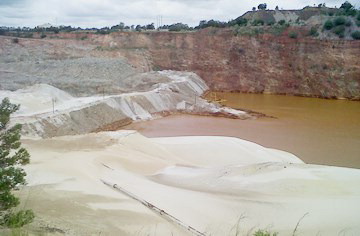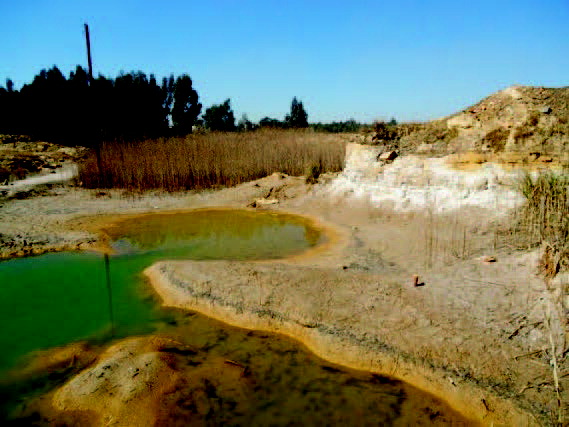
The project team expects to visit more abandoned gold mines such as this one to collect samples and characterize elemental speciation and distribution. (Photo courtesy Dr. Tutu).
|
Dr. Tutu's PEER project has come to an end. He and his team achieved a number of milestones that can be summarized as follows.
Water is a scarce resource in South Africa, as it is in most of the countries. The few available resources tend to be contaminated, leaving communities with little choice but to use such contaminated resources. This research explored the possibility of using cost effective methods to remediate mine contaminated water and to recover any potential value from it. A variety of adsorbents that can now be deployed to the sites were developed and tested at laboratory scale. These adsorbents showed potential to remove toxic elements such as uranium, mercury and lead from contaminated water, thus rendering the water safe to use by households. Recovery of low levels of gold from the mine leachates was found to be possible using modified zeolites that tend to be very selective.
Through PEER funding, Bronwyn Camden-Smith graduated with a PhD in July 2016. Her research work was based on water chemistry characterization and modeling of processes related to the distribution, transport and speciation of elements in mining environments. Over 6 publications and a book chapter were realized from her work.
Two BSc Honors students were also recruited, Tshepiso Mpala and Tshegofatso Mabilane. Ms Mpala’s project focused on using modeling to predict changes in water chemistry in an acid mine drainage treatment plant. The findings showed that it is possible to reduce the amount of neutralizing agents e.g. lime without compromising the quality of the resulting treated water as long as the sludge produced within the process was recycled and used to condition the incoming acidic water. Furthermore, the work showed that it is possible to use modeling as an integral part of the process design and optimization.
Ms Mabilane contributed to a project on recovering low levels of gold in mine leachates using a sulphur modified zeolite. The project was predicated on the premise that gold that was left over by metallurgical processes and disposed in tailings leaches out over time as a result of weathering of the host ores. This gold can be salvaged by using selective adsorbents such as those containing sulphur groups as they tend to have a high affinity for gold. The adsorbents have also been found to have a high affinity for mercury, a toxic element that is usually contained in gold mine leachates.
The team's connections and collaborations with AngloGold Ashanti and the Cancer Association of South Africa (CANSA) have been strengthened. AngloGold Ashanti are interested in the possibility of reclaiming the contaminated water and the recovery of value from the water e.g. recovering low concentrations of gold from mine leachates. CANSA are interested in the effectiveness of the adsorbent materials in removing carcinogenic contaminants. Other organizations that have been engaged through the project are Mintails (a gold mining company) and the Trans Caledon Tunnel Authority (TCTA) that operates the acid mine drainage treatment plants in the Witwatersrand Basin.
In summary, the research findings have shown that it is possible to develop cost effective materials based on natural materials such as fly ash and zeolite to remove toxic elements e.g. uranium from mine contaminated water and that it is possible to use the developed materials to recover value (e.g. gold lost through leachates) from such water. The findings have also demonstrated the potential application of these materials on a large scale (e.g. fly ash-cement composite) and on a small scale (e.g. functionalized zeolite in column systems deployed in household water containers).
The PI plans to continue the deployment of adsorbents in the field, i.e. both at mine sites (bulk adsorbents) and households (small scale adsorbents). A variety of adsorbents (that have been identified as one of the spinoffs of this project) will also be studied in further projects. These have been extended to include the recovery of precious metals such as gold and silver as well as the rare earth elements.
Publications
R.H. Johnson, B.P.C. Camden-Smith and H. Tutu: Prediction of uranium transport in an aquifer at a proposed uranium in situ recovery site: geochemical modelling as a decision making tool. In Management of Radioactive and Hazardous Wastes (eds. Hosam El-Din Saleh and Rehab O. Abdel Rahman), INTECH Publishers, pp 53-67, ISBN 978-953-51-2616-4, 2016. DOI:
http://dx.doi.org/10.5772/63537E.N. Bakatula and H. Tutu: Characterisation and geochemical modelling of cyanide in effluent from an active slimes dam. S. Afr. J. Chem., 2016, 69, 140–147. DOI:
http://dx.doi.org/10.17159/0379-4350/2016/v69a17 E. Rosenberg, R. Tsosie, G. Pinson, E.M. Cukrowska and H. Tutu: Uranium remediation using ion exchange methods – a critical review. Johnson Matthey Technol. Rev., 2016, 60, (1), 59–77. DOI:
https://doi.org/10.1595/205651316X690178.
B.P.C. Grover, R.H. Johnson, D.G. Billing, I.M. Weiersbye and H. Tutu: Mineralogy and geochemistry of efflorescent minerals on mine tailings and their potential impact on water chemistry. Environmental Science and Pollution Research 23 (2016), 7338–7348. DOI:
https://doi.org/10.1007/s11356-015-5870-zB.P.C. Camden-Smith, R.H. Johnson and H. Tutu: Leachability of metals in gold tailings by rainwater: an experimental and geochemical modelling approach. Water SA 42 (2016), 38-42. DOI:
http://dx.doi.org/10.4314/wsa.v42i1.05.
R.H. Johnson and H. Tutu: Predictive Reactive Transport Modeling at a Proposed Uranium In Situ Recovery Site with a General Data Collection Guide. Mine Water Environ 35(2016) 369-380. DOI:
https://doi.org/10.1007/s10230-015-0376-y.





